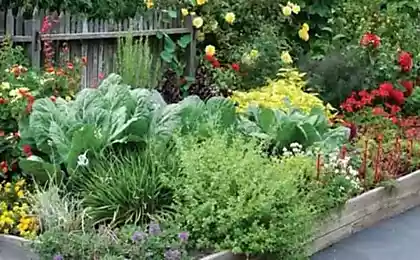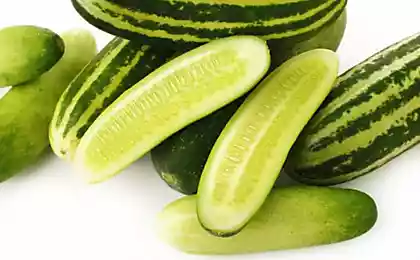159
Planted a magical plant next to cucumbers, collected 3 times more cucumbers from one bed, I share a positive experience
For the sake of a generous harvest, many summer residents are ready to work without raising their heads. “Rest”, sometimes, all day on the beds, and by the evening you just fall, complaining of pressure and low back pain. Familiar painting? What if we said there was a way to significantly increase the yield of cucumbers even without much effort on your part?

The homeland of cucumbers is India, and a distant relative of pumpkin and melon came to us in the XVII century and immediately fell in love with the common people. Familiar to us since childhood, the plant comes from the subtropics, so loves high temperature and humidity.

In addition to weather conditions, the harvest of cucumbers is affected by many factors: quality seeds, the formation of whips, watering, feeding, crop rotation and the presence of useful neighbors. The yield rate also varies greatly among different varieties and hybrids.

Of course, these are only the numbers on the seed packet, but their spread is impressive and gives rise to thought. So for the old variety "Monastic" is 3 kilograms per square meter. And for the new hybrid "Courage F1" - 16 kilograms of fruit from the same area.

The statistics are also interesting. According to the UN, the average yield of cucumbers in the Netherlands is 7 (!) times higher than in Spain (68.9 kg / m2 against 8.4 kg / m2). At the same time, for example, in Romania, the yield of cucumbers is only 1.39 kg / m2.
How to increase the yield Cucumbers respond well to feeding. If you do not have the desire or time to prepare them with your own hands, you can use ready-made drugs Radipharm, Benefit and Megafol.

For beginners, the most affordable option for fertilizing cucumbers is “herbal tea”. You only need three components: water, weeds from your site and a handful of nitrogen fertilizers to improve fermentation. One barrel of 200 liters during the summer with a margin will provide a standard garden plot with food.

As we have said, cucumbers require constant moisture, as in their native subtropics. At the same time, not only under the root, but also on the leaf. Therefore, the best method of irrigation will be raining and drip irrigation. Maintaining soil moisture at an optimal level will also help mulching beds.
Crop rotation and companion plants If year from year to year to plant cucumbers in one place, a shortage of microelements consumed by vegetables will accumulate in the soil. It also creates conditions for the spread of infection and the reproduction of pests. This problem is especially relevant for greenhouses, where soil replacement is required every few years.

A way out of this situation can be the sowing of ciderates. For example, legumes (soybeans, lupins, vica, beans, peas) return nitrogen to the soil, which cucumbers so greedily absorb. Thanks to this, the harvest of the bubble vegetable can be increased many times.
Cold-resistant mustard can be sown on cucumber beds in early spring so that it rises before planting cucumbers. This wonderful plant secretes phytoncides that inhibit the growth of mold fungi and pathogens. The cucumbers planted after it practically do not get sick.

It should also be noted that when growing on neighboring beds of vegetables from the same family (pumpkin, squash, zucchini), the yield of cucumbers decreases, and the incidence increases. If you plant cucumbers with beans and corn, the yield on the contrary increases. Corn gives shade and serves as a good support for cucumbers, and beans enrich the soil with nitrogen.
The harvest of cucumbers in the greenhouse can be significantly raised, increasing the concentration of carbon dioxide in the air. To do this, you only need to install a barrel of water and dung inside.
Experienced summer residents know that the trellis for cucumbers allows you to get a generous harvest and greatly facilitates the care of this climbing plant. We tell you how to make the simplest collapsible tapestry with your own hands.

The homeland of cucumbers is India, and a distant relative of pumpkin and melon came to us in the XVII century and immediately fell in love with the common people. Familiar to us since childhood, the plant comes from the subtropics, so loves high temperature and humidity.

In addition to weather conditions, the harvest of cucumbers is affected by many factors: quality seeds, the formation of whips, watering, feeding, crop rotation and the presence of useful neighbors. The yield rate also varies greatly among different varieties and hybrids.

Of course, these are only the numbers on the seed packet, but their spread is impressive and gives rise to thought. So for the old variety "Monastic" is 3 kilograms per square meter. And for the new hybrid "Courage F1" - 16 kilograms of fruit from the same area.

The statistics are also interesting. According to the UN, the average yield of cucumbers in the Netherlands is 7 (!) times higher than in Spain (68.9 kg / m2 against 8.4 kg / m2). At the same time, for example, in Romania, the yield of cucumbers is only 1.39 kg / m2.
How to increase the yield Cucumbers respond well to feeding. If you do not have the desire or time to prepare them with your own hands, you can use ready-made drugs Radipharm, Benefit and Megafol.

For beginners, the most affordable option for fertilizing cucumbers is “herbal tea”. You only need three components: water, weeds from your site and a handful of nitrogen fertilizers to improve fermentation. One barrel of 200 liters during the summer with a margin will provide a standard garden plot with food.

As we have said, cucumbers require constant moisture, as in their native subtropics. At the same time, not only under the root, but also on the leaf. Therefore, the best method of irrigation will be raining and drip irrigation. Maintaining soil moisture at an optimal level will also help mulching beds.
Crop rotation and companion plants If year from year to year to plant cucumbers in one place, a shortage of microelements consumed by vegetables will accumulate in the soil. It also creates conditions for the spread of infection and the reproduction of pests. This problem is especially relevant for greenhouses, where soil replacement is required every few years.

A way out of this situation can be the sowing of ciderates. For example, legumes (soybeans, lupins, vica, beans, peas) return nitrogen to the soil, which cucumbers so greedily absorb. Thanks to this, the harvest of the bubble vegetable can be increased many times.
Cold-resistant mustard can be sown on cucumber beds in early spring so that it rises before planting cucumbers. This wonderful plant secretes phytoncides that inhibit the growth of mold fungi and pathogens. The cucumbers planted after it practically do not get sick.

It should also be noted that when growing on neighboring beds of vegetables from the same family (pumpkin, squash, zucchini), the yield of cucumbers decreases, and the incidence increases. If you plant cucumbers with beans and corn, the yield on the contrary increases. Corn gives shade and serves as a good support for cucumbers, and beans enrich the soil with nitrogen.
The harvest of cucumbers in the greenhouse can be significantly raised, increasing the concentration of carbon dioxide in the air. To do this, you only need to install a barrel of water and dung inside.
Experienced summer residents know that the trellis for cucumbers allows you to get a generous harvest and greatly facilitates the care of this climbing plant. We tell you how to make the simplest collapsible tapestry with your own hands.
Parents told the boy that they are waiting for gifts, because on the New Year it is supposed to give loved ones something expensive and pleasant.
Frosya Burlakova flew to the sky very early, but left her son her acting talent






















